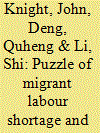| Srl | Item |
| 1 |
ID:
089971


|
|
|
|
|
| Publication |
2009.
|
| Summary/Abstract |
This paper contributes to the pool of studies of rural underemployment and revisits a number of estimates of surplus agricultural labour in China. The study is devoted to the conceptualization, identification and measurement of surplus at regional, provincial and national levels by a stochastic frontier functional specification. The analysis indicates that the existing size of agricultural surplus labour is still significantly large with the continued practice of the household registration system and China's WTO membership.
|
|
|
|
|
|
|
|
|
|
|
|
|
|
|
|
| 2 |
ID:
110502


|
|
|
|
|
| Publication |
2011.
|
| Summary/Abstract |
Many recent studies claim that China has reached a Lewisian 'turning point' in economic development, signalled by rising wages in urban areas and the exhaustion of rural surplus labour. In this paper we show that despite some evidence of rising nominal urban unskilled wages between 2000 and 2009, there is little in the data to suggest that this wage increase has been caused by unskilled labour shortages. China still has abundant under-employed workers with very low income in the rural sector. We argue that China's unique institutional and policy-induced barriers to migration have both prevented many rural workers from migrating to cities and also reduced the migrants' length of stay. We project that under alternative institutional settings, the migrant stock could easily be doubled from the current 150 million to 300 million by increasing either the average length of migrant stay, or the migrant inflow, or both.
|
|
|
|
|
|
|
|
|
|
|
|
|
|
|
|
| 3 |
ID:
110504


|
|
|
|
|
| Publication |
2011.
|
| Summary/Abstract |
The paper examines the contentious issue of the extent of surplus labour that remains in China. China was an extreme example of a surplus labour economy, but the rapid economic growth during the period of economic reform requires a reassessment of whether the second stage of the Lewis model has been reached or is imminent. The literature is inconclusive. On the one hand, there are reports of migrant labour scarcity and rising migrant wages; on the other hand, estimates suggest that a considerable pool of relatively unskilled labour is still available in the rural sector. Yet the answer has far-reaching developmental and distributional implications. After reviewing the literature, the paper uses the 2002 and 2007 national household surveys of the Chinese Academy of Social Sciences to analyse and explain migrant wage behaviour, to predict the determinants of migration, and to examine the size and nature of the pool of potential rural-urban migrants. An attempt is also made to project the rural and urban labour force and migration forward to 2020, on the basis of the 2005 1% Population Survey. The paper concludes that for institutional reasons both phenomena are likely to coexist at present and for some time in the future.
|
|
|
|
|
|
|
|
|
|
|
|
|
|
|
|
| 4 |
ID:
117919


|
|
|
|
|
| Publication |
2013.
|
| Summary/Abstract |
It has been widely recognised that China has had a large pool of surplus labour. However, despite its significant implications for wage levels and the Chinese economy, the current debates yield conflicting results as to whether a Lewis turning point has been reached. This paper clarifies a theoretical issue about the mechanisms of surplus labour absorption, subsequently indentifies two Lewis turning points and examines the factors that affect the reaching of these two points. It then applies the framework to China to study the labour absorption process and examines some of the likely implications of the removal of the Hukou system in terms of welfare and economic performance.
|
|
|
|
|
|
|
|
|
|
|
|
|
|
|
|